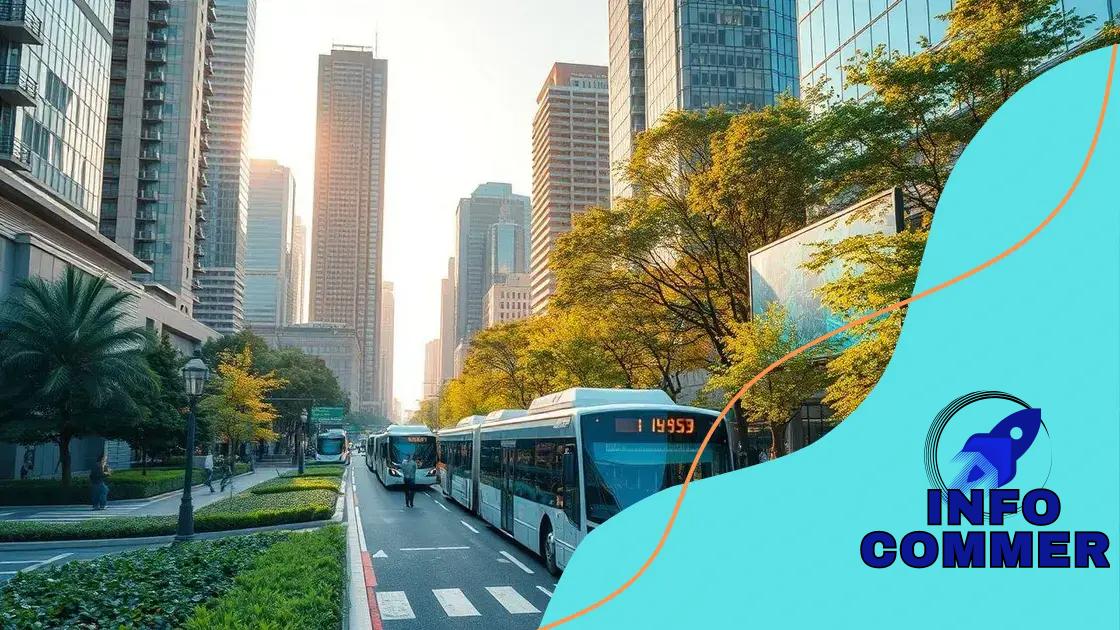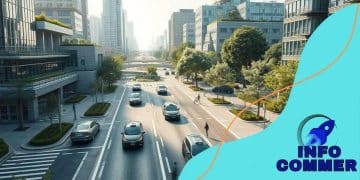Smart cities with sustainable solutions and infrastructure

Smart cities utilize advanced technologies, such as AI and IoT, to enhance urban living through improved efficiency, sustainability, and community engagement, while addressing challenges like cost and data privacy.
Smart cities with sustainable solutions and infrastructure are becoming essential in urban planning. Have you ever wondered how these cities improve our daily lives? Let’s dive into the innovative ways they’re reshaping our communities.
Understanding smart cities
Understanding smart cities is vital in our increasingly urban world. These cities leverage technology to improve the quality of life for their residents. From efficient transportation to advanced energy solutions, smart cities are at the forefront of urban innovation.
Key Features of Smart Cities
Several essential features define a smart city:
- Connected Infrastructure: Technologies like sensors and IoT devices gather data to optimize city services.
- Sustainable Practices: Eco-friendly solutions reduce waste and energy consumption.
- Efficient Public Transport: Smart transit systems help citizens navigate better.
- Data-Driven Decision Making: City planners use real-time data to enhance urban planning.
A smart city not only focuses on technology but also on community engagement. Residents participate in decision-making through platforms that encourage feedback. This collaborative approach fosters a sense of ownership over community initiatives.
The Role of Technology
Technology plays an integral role in the functioning of smart cities. It enables better resource management and enhances the city’s responsiveness. By integrating technologies like artificial intelligence and big data, cities can predict challenges and address them proactively.
For instance, traffic management systems can analyze data to adjust signal timings in real-time, reducing congestion and improving air quality.
This responsive approach not only addresses immediate urban issues but also helps build a sustainable future for the city. Smart cities are evolving to become more adaptive and resilient, which is crucial in the face of global challenges such as climate change.
Incorporating sustainable solutions is a key aspect of smart cities. Innovations in renewable energy, such as solar panels and wind turbines, support the city’s energy needs. Additionally, promoting green spaces and urban forests enhances overall urban livability.
What we see is that smart cities are more than just technology hubs. They are well-planned ecosystems that empower communities, enhance connectivity, and foster innovation. The future of urban living is undoubtedly tied to our understanding of these emerging cities.
Key components of sustainable infrastructure
The key components of sustainable infrastructure are essential for building cities that thrive for future generations. These elements work together to create an environment that minimizes waste and maximizes efficiency.
Essential Elements
Sustainable infrastructure includes several core components:
- Green Building Materials: Using sustainable materials reduces environmental impact.
- Water Efficiency: Systems that conserve water resources are critical in urban settings.
- Renewable Energy Sources: Integrating solar, wind, and other renewable energies supports a cleaner energy grid.
- Smart Waste Management: Technologies to recycle and manage waste lead to cleaner cities.
Each of these components plays an important role in creating a sustainable city. For instance, utilizing green building materials not only reduces carbon emissions but also enhances the quality of living for residents. Efficient designs make buildings more resilient and energy-efficient, leading to lower operational costs.
Incorporating water-efficient systems ensures that cities do not overuse this precious resource. Techniques such as rainwater harvesting and greywater recycling support local ecosystems and reduce the risk of droughts.
Importance of Renewable Energy
Implementing renewable energy sources is another critical aspect of sustainable infrastructure. Cities need to transition to clean energy to reduce greenhouse gas emissions. Solar panels and wind turbines are becoming more common, supporting the sustainability goals of urban areas.
Smart waste management systems use technology to streamline recycling and waste collection processes. This innovation not only minimizes landfill contributions but also encourages recycling practices among residents.
Overall, the integration of these components fosters resilience and sustainability in cities. By prioritizing these practices, urban planners can create environments that support both people and the planet.
Benefits of smart solutions in urban areas

The benefits of smart solutions in urban areas are significant and far-reaching. By leveraging technology, cities can improve the quality of life for their residents, making urban living more enjoyable and efficient.
Enhanced Efficiency
One major benefit is enhanced efficiency. Smart technologies streamline processes in numerous sectors, like energy and transportation. Smart energy grids adjust in real-time based on demand, ensuring that energy use is optimized and waste is minimized.
Additionally, public transportation systems equipped with real-time tracking apps allow commuters to plan their trips better, reducing wait times and congestion. These systems provide valuable data that help cities make informed decisions about service improvements.
Improved Sustainability
Smart solutions also contribute to sustainability in urban areas. Innovative water management systems make it possible to monitor and conserve water like never before. Through sensor technology, cities can detect leaks and reduce waste, promoting responsible water usage.
- Reduced Carbon Footprint: Smart solutions lower greenhouse gas emissions through efficient energy use.
- Promoting Green Spaces: Incorporating park management systems helps maintain and enhance urban green areas.
- Waste Management Innovation: Smart bins can alert waste management services when they need collection, optimizing routes and decreasing vehicle emissions.
- Public Health Benefits: Improved air quality monitoring leads to a healthier urban environment.
Furthermore, smart solutions promote social inclusivity and safety. Cities that deploy smart surveillance systems can enhance public safety without intruding on personal privacy. Smart lighting systems can illuminate public spaces, making them safer at night.
Overall, the integration of smart solutions transforms urban living. By addressing critical issues like sustainability and safety, cities foster vibrant communities where residents thrive.
Challenges in implementing smart city technologies
Implementing smart city technologies presents several challenges that urban planners and city officials must navigate. These challenges can affect the success and efficiency of smart city projects, making it vital to understand them clearly.
High Initial Costs
One significant challenge is the high initial costs associated with setting up smart technologies. Cities often need to invest in new infrastructure, which can strain budgets. This upfront investment can lead to delays in project initiation and can even deter cities from pursuing smart solutions altogether.
Moreover, funding can come from various sources, including government grants and private partnerships. However, securing these funds can be a lengthy process.
Data Privacy and Security
Another challenge involves data privacy and security. Smart cities collect vast amounts of data through connected devices. Ensuring that this data is protected from breaches is crucial. Residents often worry about how their data is used, which can lead to resistance against smart initiatives.
- Public Acceptance: Gaining trust from citizens is essential for successful technology adoption.
- Governance Issues: Clear policies are needed to manage data responsibly.
- Compliance with Regulations: Cities must ensure their tech solutions adhere to legal standards.
- Transparency: Open communication with citizens about data usage builds trust.
Furthermore, integrating legacy systems with new technologies can be complex. Many cities already have established systems that may not easily connect with new smart solutions. This can lead to efficiency issues and may require additional investment to overcome these integration hurdles.
Finally, the rapidly evolving nature of technology poses a challenge. Keeping up with the latest advancements requires ongoing training and education for city staff. Cities must ensure that their teams are equipped to manage and utilize new tech effectively.
These challenges underline the importance of thorough planning and community involvement in the development of smart cities. Addressing these issues can pave the way for successful implementation of smart solutions.
Future trends in smart city development
The future trends in smart city development are set to redefine urban living. As technology advances, cities will become more connected, efficient, and sustainable. These developments promise to improve the quality of life for residents while addressing pressing urban challenges.
Integration of Artificial Intelligence
One exciting trend is the integration of artificial intelligence (AI) into city infrastructure. AI will help analyze data collected from various sources, providing insights for better decision-making. For example, AI-driven traffic management systems can reduce congestion by optimizing traffic signals based on real-time data.
Increased Use of IoT
The Internet of Things (IoT) is transforming how cities operate. Many devices will be connected, creating a network that shares vital information. These connections allow for smarter energy usage and enhanced public services.
- Smart Lighting: Streetlights that adjust brightness based on pedestrian activity improve safety and save energy.
- Waste Management: Smart bins will notify collection services when they are full, enhancing efficiency in waste pickup.
- Smart Water Systems: Sensors will monitor water usage and detect leaks, reducing waste.
- Connected Vehicles: Vehicles will communicate with traffic systems to improve safety and traffic flow.
Furthermore, a strong focus on sustainability will shape the future of smart cities. Urban planners will prioritize green spaces and renewable energy sources. Solar panels and wind turbines will be common sights, helping cities to reduce their carbon footprints.
Moreover, public participation will increasingly guide development. City planners will engage communities in decision-making processes, ensuring that residents’ needs and desires are met. This collaboration fosters a sense of ownership and connection between citizens and their communities.
Another trend is the rise of digital twins—virtual replicas of physical city environments. These models enable city planners to simulate changes and test solutions before implementing them in real life. With this technology, cities can more effectively address challenges like climate change, infrastructure strain, and population growth.
As we look towards the future, it is clear that smart city development is on a path to create more livable, efficient, and sustainable urban environments. Through embracing innovation and fostering community engagement, cities will thrive in the coming years.
FAQ – Frequently Asked Questions about Smart Cities
What are smart cities?
Smart cities use technology and data to enhance urban living, making cities more efficient, sustainable, and connected.
How does technology improve urban living?
Technologies like AI and IoT streamline processes, improve transportation, and enhance public services, leading to a better quality of life.
Why is community involvement important in smart city development?
Community involvement ensures that the needs and desires of residents are met, creating a sense of ownership and fostering support for smart initiatives.
What are the main challenges in implementing smart city technologies?
Challenges include the high initial costs, data privacy concerns, integrating new tech with existing systems, and keeping up with rapid technological changes.





